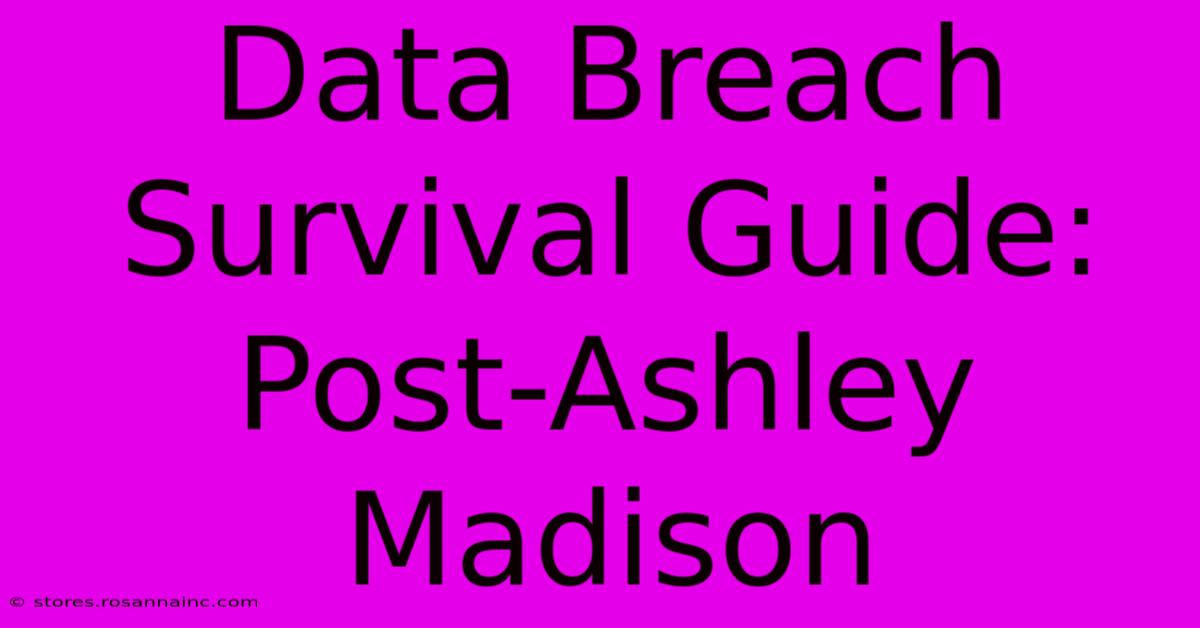Data Breach Survival Guide: Post-Ashley Madison

Table of Contents
Data Breach Survival Guide: Post-Ashley Madison
The Ashley Madison data breach in 2015 sent shockwaves through the online world, exposing the personal information of millions of users. This wasn't just a technical failure; it was a stark reminder of the vulnerability of our digital lives and the devastating consequences of a data breach. While the Ashley Madison incident may seem like ancient history, its lessons remain profoundly relevant. This guide provides crucial steps to take before, during, and after a data breach, helping you navigate the treacherous waters of online security.
Understanding the Risks: Beyond Ashley Madison
The Ashley Madison breach wasn't unique. Data breaches are increasingly common, targeting individuals, businesses, and governments alike. From social media platforms to healthcare providers, no organization is entirely immune. The types of data compromised can vary widely, including:
- Personally Identifiable Information (PII): Names, addresses, phone numbers, email addresses, dates of birth.
- Financial Information: Credit card numbers, bank account details, social security numbers.
- Medical Information: Health records, diagnoses, treatment details.
- Sensitive Personal Information: Passwords, sexual preferences (as seen in the Ashley Madison case), political affiliations.
Preemptive Measures: Building a Strong Security Foundation
Proactive steps are crucial to minimizing the damage of a potential breach. These preventative measures are your first line of defense:
Strong Passwords and Authentication:
- Use unique, strong passwords: Avoid reusing passwords across different accounts. Use a password manager to generate and store complex passwords securely.
- Enable two-factor authentication (2FA): This adds an extra layer of security, requiring a second verification method (like a code from your phone) in addition to your password. This is arguably the single most important step you can take.
- Regularly update passwords: Change your passwords periodically, especially for sensitive accounts.
Monitor Your Accounts:
- Enable security alerts: Set up alerts from your email provider, bank, and other important accounts to notify you of suspicious activity.
- Regularly check your credit report: Look for any unauthorized activity or accounts opened in your name. You're entitled to a free credit report annually from each of the three major credit bureaus (Equifax, Experian, and TransUnion).
Secure Your Devices:
- Use strong antivirus and anti-malware software: Keep it updated regularly.
- Keep your software updated: Regularly update your operating system, apps, and browser to patch security vulnerabilities.
- Be wary of phishing scams: Don't click on suspicious links or open attachments from unknown senders.
During a Breach: Immediate Actions
If you discover your data has been compromised, act swiftly:
- Change your passwords immediately: Start with accounts that might have been directly affected.
- Contact your financial institutions: Report any potential compromise of your financial information and consider placing a fraud alert or freeze on your credit.
- Monitor your accounts closely: Watch for unusual activity and report anything suspicious.
- Consider identity theft protection services: These services can provide monitoring and assistance in the event of identity theft.
Post-Breach Recovery: Protecting Your Future
Even after the immediate crisis has passed, the consequences of a data breach can linger. Take these steps to secure your future:
- Continue monitoring your accounts: Remain vigilant for any further suspicious activity.
- Review your privacy settings on social media and other online platforms: Limit the amount of personal information you share publicly.
- Educate yourself about online security best practices: Stay informed about new threats and vulnerabilities.
- Report the breach to the appropriate authorities: If you believe you've been a victim of a crime, report it to law enforcement.
The Ashley Madison data breach served as a harsh lesson in the importance of online security. By proactively protecting yourself and responding effectively to a breach, you can significantly reduce your risk and mitigate the potential damage. Remember, your digital safety is your responsibility. Don't wait for a breach to happen – take action today.

Thank you for visiting our website wich cover about Data Breach Survival Guide: Post-Ashley Madison. We hope the information provided has been useful to you. Feel free to contact us if you have any questions or need further assistance. See you next time and dont miss to bookmark.
Featured Posts
-
The Shocking Truth About Tucker Carlsons Wealth
Feb 10, 2025
-
Tom Cruises On Set Collapse
Feb 10, 2025
-
Eagles Gegen Chiefs Super Bowl Liveticker
Feb 10, 2025
-
Area Code 319 Your Guide To This Mysterious Location
Feb 10, 2025
-
Is Lena Derricott Bell King The Answer You Ve Been Searching For
Feb 10, 2025
